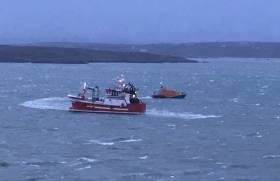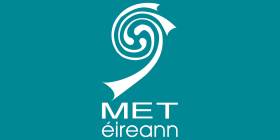Displaying items by tag: Storm Hannah
Baltimore & Portaferry Lifeboats Launch During Storm Hannah
Lifeboats in Baltimore and Portaferry were launched yesterday evening (Friday 26 April) as Storm Hannah swept over the island of Ireland.
Baltimore RNLI’s volunteer lifeboat crew launched their all-weather lifeboat at 8.30pm after learning of a local fishing trawler that was dragging its anchor in high winds near Sherkin Island in West Cork.
The lifeboat arrived on scene at 8.43pm and transferred four extra crew aboard the 26.2m trawler. Once they were satisfied that the casualty vessel was back at safe anchor, the lifeboat returned to station by 9.11pm as the storm intensified.
Conditions at sea during the callout were very rough, with Force 10 winds gusting to Force 11, and a two-metre sea swell within the harbour.
Elsewhere, the volunteer lifeboat crew from Portaferry RNLI launched to reports of a missing dingy with three people on board.
The lifeboat crew proceeded to Pig Island near Newtownards in Strangford Lough and were joined in the search by local coastguard and Rescue 119 from Preswick in Scotland.
However, all rescue teams were stood down after a thorough search of the area revealed nothing.
Commenting on the callout, Jordan Conway, Portaferry RNLI lifeboat press officer, said: “Despite the weather conditions deteriorating as the volunteer lifeboat crew reached the scene, a full search was carried out in conjunction with our colleagues in the coastguard and Rescue 119.”
As previously reported on Afloat.ie, Castletownbere RNLI also launched last night to a 33ft fishing vessel which lost all power in Bere Haven Harbour are the storm bore down.
While the severe weather has now passed, sea conditions will remain rough over the next few days, and Baltimore RNLI’s Kate Callanan urged anyone on or near the water to “exercise caution in particular along the coastline.
“If you get into trouble or see anyone in difficulty at sea or along the coast, call 999 or 112 and ask for the coastguard.”
Status Red Upgrade For Co Clare As Storm Hannah Sweeps In
The weather warning issued by Met Éireann for Co Clare has been upgraded to the most severe Status Red as Storm Hannah is expect to brings gusts of up to 150km/h this evening (Friday 26 April).
Meanwhile, the marine warning has been upgraded to Status Orange, as cyclonic variable winds will increase to gale Force 8 or strong gale Force 9 on Irish coastal waters from Howth Head to Mizen Head to Rossan Point and on the south Irish Sea during this afternoon and evening.
Winds are forecast to reach storm Force 10 to violent storm Force 11 this evening and early tonight between Carnsore Point and Slyne Head.
The extreme weather has seen the cancellation of sailing and watersport events nationwide, including rowing’s Limerick Regatta which had been scheduled for tomorrow.
Small Craft Warning Ahead of Storm Hannah’s Arrival Tomorrow
Met Éireann has issued a Status Yellow small craft warning for Force 6 southerly winds later today and tonight (Thursday 25 April) on coasts from Belfast Lough to Howth Head to Carnsore Point ahead of Storm Hannah’s arrival tomorrow.
A Status Orange wind warning has been issued by the weather service for counties Clare, Cork, Kerry and Limerick effective from 4pm tomorrow afternoon till early Saturday morning as southerly winds, later veering north-westerly, will each means speeds of up to 80km/h with gusts of 110 to 130 km/h.
Meanwhile, Connacht, Carlow, Kildare, Kilkenny, Laois, Longford, Wexford, Wicklow, Offaly, Donegal, Tipperary and Waterford are under a Status Yellow alert from tomorrow night.
The Irish Meteorological Service has warned the public to be prepared for possible disruption and power outages from the storm, the eighth of the current cycle.
href="https://twitter.com/hashtag/StormHannah?src=hash&ref_src=twsrc%5Etfw">#StormHannah has been named by @MetEireann. The storm will bring severe gales to Ireland on Friday night, with strong winds also expected for southern parts of the UK pic.twitter.com/esuddjvNyP— Met Office (@metoffice) April 25, 2019































































